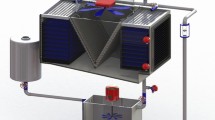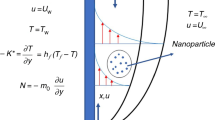Abstract
Density is among the fundamental thermo-physical characteristics of fluids that are examined prior to carrying out performance analysis of the fluid. In this study, the effect of the design variables on the density of nanofluids was studied using response surface methodology (RSM). The quadratic model produced by RSM was employed to determine the performance factors, i.e., mass concentration and temperature with reasonably good accuracy. Improved experimental correlations were proposed for the density prediction of the carbon-based nanofluids based on the experimental data. Experimentally measured densities of two different nanofluids at the nanoparticle mass concentration of up to 0.1% and the temperature range of 20–40 °C were examined. The improvement in densities compared to the density of base fluid at 20 and 40 °C is approximately 0.15% for 0.1% fraction of MWCNT–COOH nanoparticles. Additionally, the densities of F-GNP nanofluids are increased by 0.056% compared to the density of distilled water. As a final point, the RSM results were compared with the results which got from the empirical data. It was detected that the optimal RSM model is accurate and the absolute maximum deviation measured values from the predicted densities of MWCNT–COOH and F-GNP nanofluids are 0.012 and 0.009%, respectively.







Similar content being viewed by others
References
Cheng L. Nanofluid heat transfer technologies. Recent Pat Eng. 2009;3(1):1–7.
Chol S. Enhancing thermal conductivity of fluids with nanoparticles. ASME Publ Fed. 1995;231:99–106.
Yarmand H, Gharehkhani S, Ahmadi G, Shirazi SFS, Baradaran S, Montazer E, et al. Graphene nanoplatelets–silver hybrid nanofluids for enhanced heat transfer. Energy Convers Manag. 2015;100:419–28.
Khoshvaght-Aliabadi M. Influence of different design parameters and Al2O3-water nanofluid flow on heat transfer and flow characteristics of sinusoidal-corrugated channels. Energy Convers Manag. 2014;88:96–105.
Yarmand H, Ahmadi G, Gharehkhani S, Kazi SN, Safaei MR, Alehashem MS, et al. Entropy generation during turbulent flow of zirconia-water and other nanofluids in a square cross section tube with a constant heat flux. Entropy. 2014;16(11):6116–32.
Peyghambarzadeh S, Hashemabadi S, Chabi A, Salimi M. Performance of water based CuO and Al2O3 nanofluids in a Cu–Be alloy heat sink with rectangular microchannels. Energy Convers Manag. 2014;86:28–38.
H-t Zhu, Y-s Lin, Y-s Yin. A novel one-step chemical method for preparation of copper nanofluids. J Colloid Interface Sci. 2004;277(1):100–3.
Esfe MH, Saedodin S, Mahian O, Wongwises S. Thermal conductivity of Al2O3/water nanofluids. J Therm Anal Calorim. 2014;117(2):675–81.
Navaei A, Mohammed H, Munisamy K, Yarmand H, Gharehkhani S. Heat transfer enhancement of turbulent nanofluid flow over various types of internally corrugated channels. Powder Technol. 2015;286:332–41.
Montazer E, Salami E, Yarmand H, Kazi S, Badarudin A editors. The RSM approach to develop a new correlation for density of metal-oxide aqueous nanofluids. In: IOP conference series: materials science and engineering. IOP Publishing; 2017.
Choi S, Zhang Z, Yu W, Lockwood F, Grulke E. Anomalous thermal conductivity enhancement in nanotube suspensions. Appl Phys Lett. 2001;79(14):2252–4.
Turgut A, Tavman I, Chirtoc M, Schuchmann H, Sauter C, Tavman S. Thermal conductivity and viscosity measurements of water-based TiO2 nanofluids. Int J Thermophys. 2009;30(4):1213–26.
Karthikeyan N, Philip J, Raj B. Effect of clustering on the thermal conductivity of nanofluids. Mater Chem Phys. 2008;109(1):50–5.
Das SK, Putra N, Thiesen P, Roetzel W. Temperature dependence of thermal conductivity enhancement for nanofluids. J Heat Transf. 2003;125(4):567–74.
Yarmand H, Gharehkhani S, Shirazi SFS, Amiri A, Alehashem MS, Dahari M, et al. Experimental investigation of thermo-physical properties, convective heat transfer and pressure drop of functionalized graphene nanoplatelets aqueous nanofluid in a square heated pipe. Energy Convers Manag. 2016;114:38–49.
Ahammed N, Asirvatham LG, Wongwises S. Effect of volume concentration and temperature on viscosity and surface tension of graphene–water nanofluid for heat transfer applications. J Therm Anal Calorim. 2016;123(2):1399–409.
Sudeep P, Taha-Tijerina J, Ajayan P, Narayanan T, Anantharaman M. Nanofluids based on fluorinated graphene oxide for efficient thermal management. RSC Adv. 2014;4(47):24887–92.
Hwang Y, Ahn Y, Shin H, Lee C, Kim G, Park H, et al. Investigation on characteristics of thermal conductivity enhancement of nanofluids. Curr Appl Phys. 2006;6(6):1068–71.
Nikkhah Z, Karimipour A, Safaei MR, Forghani-Tehrani P, Goodarzi M, Dahari M, et al. Forced convective heat transfer of water/functionalized multi-walled carbon nanotube nanofluids in a microchannel with oscillating heat flux and slip boundary condition. Int Commun Heat Mass Transf. 2015;68:69–77.
Estellé P, Halelfadl S, Maré T. Thermophysical properties and heat transfer performance of carbon nanotubes water-based nanofluids. J Therm Anal Calorim. 2017;127(3):2075–81.
Timofeeva EV, Moravek MR, Singh D. Improving the heat transfer efficiency of synthetic oil with silica nanoparticles. J Colloid Interface Sci. 2011;364(1):71–9.
Montazer E, Yarmand H, Salami E, Muhamad MR, Kazi S, Badarudin A. A brief review study of flow phenomena over a backward-facing step and its optimization. Renew Sustain Energy Rev. 2018;82:994–1005.
Yu W, Xie H, Bao D. Enhanced thermal conductivities of nanofluids containing graphene oxide nanosheets. Nanotechnology. 2009;21(5):055705.
Zheng R, Gao J, Wang J, Feng S-P, Ohtani H, Wang J, et al. Thermal percolation in stable graphite suspensions. Nano Lett. 2011;12(1):188–92.
Ding Y, Alias H, Wen D, Williams RA. Heat transfer of aqueous suspensions of carbon nanotubes (CNT nanofluids). Int J Heat Mass Transf. 2006;49(1):240–50.
Yu W, Xie H, Wang X, Wang X. Significant thermal conductivity enhancement for nanofluids containing graphene nanosheets. Phys Lett A. 2011;375(10):1323–8.
Lamas B, Abreu B, Fonseca A, Martins N, Oliveira M. Assessing colloidal stability of long term MWCNT based nanofluids. J Colloid Interface Sci. 2012;381(1):17–23.
Amiri A, Shanbedi M, Yarmand H, Arzani HK, Gharehkhani S, Montazer E, et al. Laminar convective heat transfer of hexylamine-treated MWCNTs-based turbine oil nanofluid. Energy Convers Manag. 2015;105:355–67.
Ren Y, Xie H, Cai A. Effective thermal conductivity of nanofluids containing spherical nanoparticles. J Phys D Appl Phys. 2005;38(21):3958.
Mintsa HA, Roy G, Nguyen CT, Doucet D. New temperature dependent thermal conductivity data for water-based nanofluids. Int J Therm Sci. 2009;48(2):363–71.
Chandrasekar M, Suresh S, Bose AC. Experimental investigations and theoretical determination of thermal conductivity and viscosity of Al2O3/water nanofluid. Exp Therm Fluid Sci. 2010;34(2):210–6.
Papari MM, Yousefi F, Moghadasi J, Karimi H, Campo A. Modeling thermal conductivity augmentation of nanofluids using diffusion neural networks. Int J Therm Sci. 2011;50(1):44–52.
Hosseini SM, Moghadassi A, Henneke DE. A new dimensionless group model for determining the viscosity of nanofluids. J Therm Anal Calorim. 2010;100(3):873–7.
Yarmand H, Gharehkhani S, Shirazi SFS, Amiri A, Montazer E, Arzani HK, et al. Nanofluid based on activated hybrid of biomass carbon/graphene oxide: synthesis, thermo-physical and electrical properties. Int Commun Heat Mass Transf. 2016;72:10–5.
Maiga SEB, Palm SJ, Nguyen CT, Roy G, Galanis N. Heat transfer enhancement by using nanofluids in forced convection flows. Int J Heat Fluid Flow. 2005;26(4):530–46.
Pastoriza-Gallego M, Casanova C. Legido Ja, Piñeiro M. CuO in water nanofluid: influence of particle size and polydispersity on volumetric behaviour and viscosity. Fluid Phase Equilib. 2011;300(1):188–96.
Vajjha R, Das D, Mahagaonkar B. Density measurement of different nanofluids and their comparison with theory. Pet Sci Technol. 2009;27(6):612–24.
Karimi H, Yousefi F. Application of artificial neural network–genetic algorithm (ANN–GA) to correlation of density in nanofluids. Fluid Phase Equilib. 2012;336:79–83.
Sánchez N, Martínez M, Aracil J. Selective esterification of glycerine to 1-glycerol monooleate. 2. Optimization studies. Ind Eng Chem Res. 1997;36(5):1529–34.
Box GE, Draper NR. Empirical model-building and response surfaces. New York: Wiley; 1987.
Sadollah A, Ghadimi A, Metselaar IH, Bahreininejad A. Prediction and optimization of stability parameters for titanium dioxide nanofluid using response surface methodology and artificial neural networks. Sci Eng Compos Mater. 2013;20(4):319–30.
Low KL, Tan SH, Zein SHS, McPhail DS, Boccaccini AR. Optimization of the mechanical properties of calcium phosphate/multi-walled carbon nanotubes/bovine serum albumin composites using response surface methodology. Mater Des. 2011;32(6):3312–9.
Hassan AM, Alrashdan A, Hayajneh MT, Mayyas AT. Prediction of density, porosity and hardness in aluminum–copper-based composite materials using artificial neural network. J Mater Process Technol. 2009;209(2):894–9.
Singh R, Bhoopal R, Kumar S. Prediction of effective thermal conductivity of moist porous materials using artificial neural network approach. Build Environ. 2011;46(12):2603–8.
Sumpter BG, Noid DW. On the design, analysis, and characterization of materials using computational neural networks. Annu Rev Mater Sci. 1996;26(1):223–77.
Pak BC, Cho YI. Hydrodynamic and heat transfer study of dispersed fluids with submicron metallic oxide particles. Exp Heat Transf Int J. 1998;11(2):151–70.
Kalil S, Maugeri F, Rodrigues M. Response surface analysis and simulation as a tool for bioprocess design and optimization. Process Biochem. 2000;35(6):539–50.
Montazer E, Mirzaei M, Salami E, Ward T, Romli F, Kazi S, editors. Optimization of a synthetic jet actuator for flow control around an airfoil. IOP conference series: materials science and engineering. IOP Publishing; 2016.
Rao KJ, Kim C-H, Rhee S-K. Statistical optimization of medium for the production of recombinant hirudin from Saccharomyces cerevisiae using response surface methodology. Process Biochem. 2000;35(7):639–47.
Desai KM, Survase SA, Saudagar PS, Lele S, Singhal RS. Comparison of artificial neural network (ANN) and response surface methodology (RSM) in fermentation media optimization: case study of fermentative production of scleroglucan. Biochem Eng J. 2008;41(3):266–73.
Acknowledgements
The authors gratefully acknowledge UMRG Grant RP045C-17AET, University of Malaya, Malaysia, for support to conduct this research work.
Author information
Authors and Affiliations
Corresponding authors
Ethics declarations
Conflict of interest
All authors have received research grants from University of Malaya. The authors declare that they have no conflict of interest.
Rights and permissions
About this article
Cite this article
Montazer, E., Salami, E., Yarmand, H. et al. Development of a new density correlation for carbon-based nanofluids using response surface methodology. J Therm Anal Calorim 132, 1399–1407 (2018). https://doi.org/10.1007/s10973-018-6978-4
Received:
Accepted:
Published:
Issue Date:
DOI: https://doi.org/10.1007/s10973-018-6978-4




